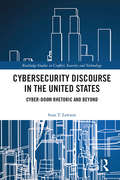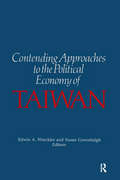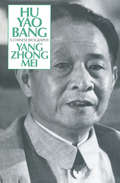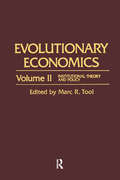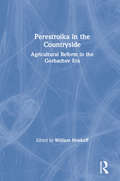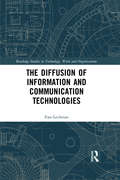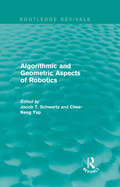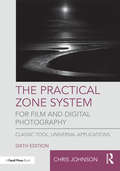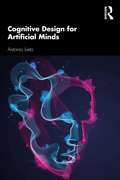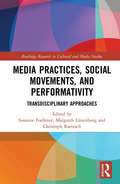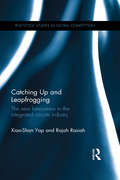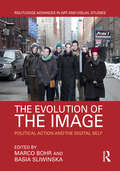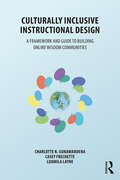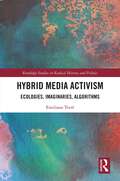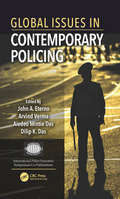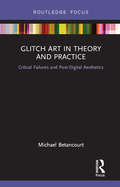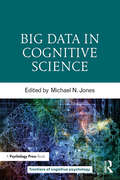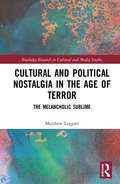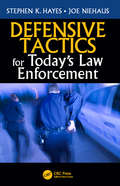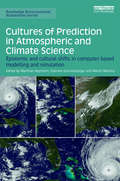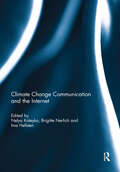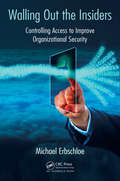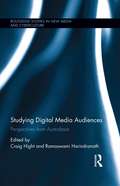- Table View
- List View
Cybersecurity Discourse in the United States: Cyber-Doom Rhetoric and Beyond (Routledge Studies in Conflict, Security and Technology)
by Sean T. LawsonThis book examines the role of cyber-doom rhetoric in the U.S. cybersecurity debate.For more than two decades, fear of "cyber-doom" scenarios—i.e. cyberattacks against critical infrastructure resulting in catastrophic physical, social, and economic impacts—has been a persistent feature of the U.S. cybersecurity debate. This is despite the fact that no cyberattack has come close to realizing such impacts. This book argues that such scenarios are part of a broader rhetoric of cyber-doom within the U.S. cybersecurity debate, and takes a multidisciplinary approach that draws on research in history, sociology, communication, psychology, and political science. It identifies a number of variations of cyber-doom rhetoric, then places them into a larger historical context, assesses how realistic the fears expressed in such rhetoric are, and finally draws out the policy implications of relying on these fears to structure our response to cybersecurity challenges. The United States faces very real cybersecurity challenges that are, nonetheless, much less dramatic than what is implied in the rhetoric. This book argues that relying on cyber-doom rhetoric to frame our thinking about such threats is counterproductive, and encourages us to develop ways of thinking and speaking about cybersecurity beyond cyber-doom.This book will be of much interest to students of cybersecurity, foreign policy, public administration, national security, and international relations in general.
The American Midwest: Managing Change in Rural Transition
by Norman WalzerThe rural Midwest is undergoing fundamental changes with increased competition from foreign agriculture; employment shifts from higher-paying manufacturing to lower-paying service industries; the displacement of local small town business by large discount stores and shopping malls; overall population declines that threaten the viability of schools, hospitals, and other public institutions, along with an influx of minority groups that has led to strife in some communities. Using data from the 2000 Census, this collection examines the major demographic and employment trends in the rural Midwestern states with special attention to the issues that state and local policy makers must address in the near future. The contributors are well known experts in their fields, and in these original, previously unpublished materials they offer suggestions on how the Internet and other technological advances offer new opportunities for rural economies that local leaders can build on.
Contending Approaches to the Political Economy of Taiwan (Taiwan In The Modern World Ser.)
by Susan Greenhalgh Edwin A. WincklerThis work compares IT parks in China, India, Malaysia, Singapore, Taiwan, and Hawaii, in search of strategies that policy makers can employ to reduce the Global Digital Divide, advance distributional equity, and soften some of the negative effects of economic globalization.
Hu Yao-Bang: A Chinese Biography
by Zhongmei YangCompares IT parks within the Asian Pacific in search of strategies that policy makers can adopt to: reduce the global digital divide; advance distributional equity; and soften some of the negative effects of economic globalization. "Best practices" are suggested based on these cases.
Evolutionary Economics
by Marc R. ToolThis two-volume work is intended to map the theoretical heartland of the institutionalist perspective on political economy. Volume I, "Foundations of Institutional Thought", identifies the origins of institutional economics and explores the primary analytical tools in its development. The papers included in Volume II, "Institutional Theory and Policy", consider basic economic processes, institutions for stabilizing and planning economic activities, the role of power and accountability, and emerging global interdependence. Marc R. Tool is the editor of "Journal of Economic Issues".
Perestroika in the Countryside: Agricultural Reform in the Gorbachev Era
by William MoskoffThis book is a collection of seven papers originally given at the 1989 meetings of the American Association for the Advancement of Slavic Studies. The authors come from the fields of economics, history, and political science and are all specialists in the field of Soviet and East European agriculture. The first essay, by David Macey, assesses Gorbachev's agricultural reform in light of the experience of the Stolypin reforms at the beginning of the century. The essays by Jim Butterfield and Ed Cook examine the impediments to successful reform from the perspective of a political scientist and an economist. Karen Brooks and Don Van Atta concentrate their attention on the efforts to introduce lease contracting into agriculture. D.Gale Johnson's essay examines the economic effects of trade liberalization in agriculture. The final paper, by Michael Marrese, suggests that there are lessons for the Soviet Union to be learned from the Hungarian experience, namely, that the changes in agriculture must be comprehensive and that the party can win over popular support if its agricultural policies succeed.
The Diffusion of Information and Communication Technologies (Routledge Studies in Technology, Work and Organizations)
by Ewa LechmanIn recent decades, the world has witnessed, unprecedented in terms of speed and geographic coverage, diffusion of new information and communication technologies (ICT). The on-going digital revolution pervasively impacts and reshapes societies and economies and therefore deserves special attention and interest. This book provides extensive evidence on information and communication technologies development patterns and dynamics of this process across developed economies over the period 1980 to the present day. It adopts newly developed methodology to identification of the ‘critical mass’ and isolation of technological takeoff intervals, which are intimately related to the process of technology diffusion. The statistically robust analysis of country-specific data demonstrates the key economic, social and institutional prerequisites of ICT diffusion across examined countries, indicating what factors significantly foster or – reversely – hinder the process.
Algorithmic and Geometric Aspects of Robotics (Routledge Revivals)
by Jacob T. Schwartz Chee-Keng YapFirst published in 1987, the seven chapters that comprise this book review contemporary work on the geometric side of robotics. The first chapter defines the fundamental goal of robotics in very broad terms and outlines a research agenda each of whose items constitutes a substantial area for further research. The second chapter presents recently developed techniques that have begun to address the geometric side of this research agenda and the third reviews several applied geometric ideas central to contemporary work on the problem of motion planning. The use of Voronoi diagrams, a theme opened in these chapters, is explored further later in the book. The fourth chapter develops a theme in computational geometry having obvious significance for the simplification of practical robotics problems — the approximation or decomposition of complex geometric objects into simple ones. The final chapters treat two examples of a class of geometric ‘reconstruction’ problem that have immediate application to computer-aided geometric design systems.
The Practical Zone System for Film and Digital Photography: Classic Tool, Universal Applications
by Chris JohnsonThis sixth edition of The Practical Zone System by Chris Johnson updates the classic manual on Ansel Adams's landmark technique for the digital age. For photographers working digitally or with film, in color or black and white, in the studio or on the go, this simple visual language helps to control contrast and, through a process called Previsualization, provides photographers with the power of free creative expression. This new edition discusses recent advances in technology and potentials for their use in zone photography, including HDR, smartphone cameras that shoot in raw format and smartphone light meters. Johnson demonstrates how the Zone System is a universal visual and conceptual language that dramatically simplifies the problem of creating and rendering complex lighting setups.
Cognitive Design for Artificial Minds
by Antonio LietoCognitive Design for Artificial Minds explains the crucial role that human cognition research plays in the design and realization of artificial intelligence systems, illustrating the steps necessary for the design of artificial models of cognition. It bridges the gap between the theoretical, experimental and technological issues addressed in the context of AI of cognitive inspiration and computational cognitive science. Beginning with an overview of the historical, methodological and technical issues in the field of Cognitively-Inspired Artificial Intelligence, Lieto illustrates how the cognitive design approach has an important role to play in the development of intelligent AI technologies and plausible computational models of cognition. Introducing a unique perspective that draws upon Cybernetics and early AI principles, Lieto emphasizes the need for an equivalence between cognitive processes and implemented AI procedures, in order to realise biologically and cognitively inspired artificial minds. He also introduces the Minimal Cognitive Grid, a pragmatic method to rank the different degrees of biologically and cognitive accuracy of artificial systems in order project and predict their explanatory power with respect to the natural systems taken as source of inspiration. Providing a comprehensive overview of cognitive design principles in constructing artificial minds, this text will be essential reading for students and researchers of artificial intelligence and cognitive science.
Media Practices, Social Movements, and Performativity: Transdisciplinary Approaches (Routledge Research in Cultural and Media Studies)
by Susanne Foellmer Margreth Lünenborg Christoph RaetzschAs individuals incorporate new forms of media into their daily routines, these media transform individuals’ engagement with networks of heterogeneous actors. Using the concept of media practices, this volume looks at processes of social and political transformation in diverse regions of the world to argue that media change and social change converge on a redefinition of the relations of individuals to larger collective bodies. To this end, contributors examine new collective actors emerging in the public arena through digital media or established actors adjusting to a diversified communication environment. The book offers an important contribution to a vibrant, transdisciplinary, and international field of research emerging at the intersections of communication, performance and social movement studies.
Guns and Crime: The Data Don't Lie
by Mark GiusGuns and Crime: The Data Don’t Lie investigates the ways in which the current data on guns and crime are inadequate and inaccurate. Although the majority of murders in the United States are committed with guns, research on gun ownership, the supply of guns, and the relationship between guns and crime is less thorough than studies done for many other aspects of public safety policy. This book explores the weaknesses in current findings, and extrapolates the implications of policymaking based on these faulty foundations. As the gun debate continues to rage in North America, this text offers a cautionary voice to the discourse—before practitioners and policy makers can create a solution to gun violence, they must first improve the quality of the facts they use to make their case. Intended for criminology, statistics, sociology, and economics students, Guns and Crime is also suitable for interested laypersons and practitioners hoping to better understand the mythos surrounding guns in America.
Catching Up and Leapfrogging: The new latecomers in the integrated circuits industry (Routledge Studies in Global Competition)
by Xiao-Shan Yap Rajah RasiahEver since Schumpeter’s groundbreaking work there has been a plethora of new research seeking to extend the direction and dynamics of innovation. Using a rich account of detailed interviews, this book offers new evidence on how latecomers have successfully caught up and leapfrogged incumbent firms. Catching Up and Leapfrogging: the new latecomers in the integrated circuits industry explores how technological transitions affect latecomer catch-up strategies, and vice versa, in a high technology industry. It looks to the East Asian latecomers who, towards the end of the twentieth century, pioneered a new pathway through organizational change by specializing in the key production stages of integrated circuits and pushing technologies further. This volume assesses how latecomer resource acquisition strategies have varied alongside structural industry changes and evaluates the mechanisms through which firms started life as technology followers and rose to become technology leaders. Xiao-Shan Yap and Rajah Rasiah present a unique story about how firm strategies evolve from the catching up phase to the leapfrogging phase, captured from the accounts of managers on the ground. It is the first time firm-level strategies have been systematically analysed to describe twenty-first century strategic management in the integrated circuits industry in particular, and the high tech industry in general. The evidence and analysis in this book offers insights for chief executive officers, policy-makers and researchers to revisit existing approaches to the theory of catching up and leapfrogging.
The Evolution of the Image: Political Action and the Digital Self (Routledge Advances in Art and Visual Studies)
by Marco Bohr Basia SliwinskaThis volume addresses the evolution of the visual in digital communities, offering a multidisciplinary discussion of the ways in which images are circulated in digital communities, the meanings that are attached to them and the implications they have for notions of identity, memory, gender, cultural belonging and political action. Contributors focus on the political efficacy of the image in digital communities, as well as the representation of the digital self in order to offer a fresh perspective on the role of digital images in the creation and promotion of new forms of resistance, agency and identity within visual cultures.
Culturally Inclusive Instructional Design: A Framework and Guide to Building Online Wisdom Communities
by Charlotte Gunawardena Casey Frechette Ludmila LayneWINNER OF THE 2019 OUTSTANDING BOOK AWARD FROM AECT'S DIVISION OF DISTANCE EDUCATION! As online courses and digital learning enable more people from more places to learn together, it is crucial for instructional design to incorporate diverse cultural perspectives. Culturally Inclusive Instructional Design provides a framework for thinking about culture in digital learning, offering insight into how to build inclusive online communities that encourage reflection and growth, regardless of content domain. Chapters cover the foundation, components, and implementation of the authors’ Wisdom Communities (WisCom) framework, which enables learners from global backgrounds to experience long-lasting, transformative learning through real-world problem-solving. This book is a timely, resourceful guide to building truly collaborative, inquiry-based online learning experiences.
Hybrid Media Activism: Ecologies, Imaginaries, Algorithms (Routledge Studies in Radical History and Politics)
by Emiliano TreréThis book is an extensive investigation of the complexities, ambiguities and shortcomings of contemporary digital activism. The author deconstructs the reductionism of the literature on social movements and communication, proposing a new conceptual vocabulary based on practices, ecologies, imaginaries and algorithms to account for the communicative complexity of protest movements. Drawing on extensive fieldwork on social movements, collectives and political parties in Spain, Italy and Mexico, this book disentangles the hybrid nature of contemporary activism. It shows how activists operate merging the physical and the digital, the human and the non-human, the old and the new, the internal and the external, the corporate and the alternative. The author illustrates the ambivalent character of contemporary digital activism, demonstrating that media imaginaries can be either used to conceal authoritarianism, or to reimagine democracy. The book looks at both side of algorithmic power, shedding light on strategies of repression and propaganda, and scrutinizing manifestations of algorithms as appropriation and resistance. The author analyses the way in which digital activism is not an immediate solution to intricate political problems, and argues that it can only be effective when a set of favourable social, political, and cultural conditions align. Assessing whether digital activism can generate and sustain long-term processes of social and political change, this book will be of interest to students and scholars researching radical politics, social movements, digital activism, political participation and current affairs more generally.
Global Issues in Contemporary Policing (International Police Executive Symposium Co-Publications)
by John A. Eterno Arvind Verma Aiedeo Mintie Das Dilip K. DasThis book addresses six areas of policing: performance management, professional and academic partnerships, preventing and fighting crime and terrorism, immigrant and multicultural populations, policing the police, and cyber-security. The book contains the most current and ground-breaking research across the world of policing with contributors from over 20 countries. It is also a suitable reference or textbook in a special topics course. It consists of edited versions of the best papers presented at the IPES annual meeting in Budapest.
Glitch Art in Theory and Practice: Critical Failures and Post-Digital Aesthetics
by Michael BetancourtGlitch Art in Theory and Practice: Critical Failures and Post-Digital Aesthetics explores the concept of "glitch" alongside contemporary digital political economy to develop a general theory of critical media using glitch as a case study and model, focusing specifically on examples of digital art and aesthetics. While prior literature on glitch practice in visual arts has been divided between historical discussions and social-political analyses, this work provides a rigorous, contemporary theoretical foundation and framework.
Big Data in Cognitive Science (Frontiers of Cognitive Psychology)
by Michael N. JonesWhile laboratory research is the backbone of collecting experimental data in cognitive science, a rapidly increasing amount of research is now capitalizing on large-scale and real-world digital data. Each piece of data is a trace of human behavior and offers us a potential clue to understanding basic cognitive principles. However, we have to be able to put the pieces together in a reasonable way, which necessitates both advances in our theoretical models and development of new methodological techniques. The primary goal of this volume is to present cutting-edge examples of mining large-scale and naturalistic data to discover important principles of cognition and evaluate theories that would not be possible without such a scale. This book also has a mission to stimulate cognitive scientists to consider new ways to harness big data in order to enhance our understanding of fundamental cognitive processes. Finally, this book aims to warn of the potential pitfalls of using, or being over-reliant on, big data and to show how big data can work alongside traditional, rigorously gathered experimental data rather than simply supersede it. In sum, this groundbreaking volume presents cognitive scientists and those in related fields with an exciting, detailed, stimulating, and realistic introduction to big data – and to show how it may greatly advance our understanding of the principles of human memory, perception, categorization, decision-making, language, problem-solving, and representation.
Cultural and Political Nostalgia in the Age of Terror: The Melancholic Sublime (Routledge Research in Cultural and Media Studies)
by Matthew LeggattThis book re-examines the role of the sublime across a range of disparate cultural texts, from architecture and art, to literature, digital technology, and film, detailing a worrying trend towards nostalgia and arguing that, although the sublime has the potential to be the most powerful uniting aesthetic force, it currently spreads fear, violence, and retrospection. In exploring contemporary culture, this book touches on the role of architecture to provoke feelings of sublimity, the role of art in the aftermath of destructive events, literature’s establishment of the historical moment as a point of sublime transformation and change, and the place of nostalgia and the returning of past practices in digital culture from gaming to popular cinema.
Defensive Tactics for Today’s Law Enforcement
by Stephen K. Hayes Joe NiehausFew of the many defensive tactics books on the market include the training and methods of martial arts. Drawing on the centuries-old techniques of Ninjutsu, Defensive Tactics for Today’s Law Enforcement offers alternatives to the traditional police defensive tactics taught to most officers. This text stresses relying on natural tendencies in a violent encounter to ensure officer safety and to better utilize the techniques and training officers do receive. By integrating existing training with martial arts expertise, Defensive Tactics provides officers access a full complement of techniques to better navigate physical conflict safely and effectively. Intended for law enforcement practitioners, as well as practitioners of any other professions that present a personal security risk, Defensive Tactics for Today’s Law Enforcement will better equip readers with a diverse range of defensive tactics.
Cultures of Prediction in Atmospheric and Climate Science: Epistemic and Cultural Shifts in Computer-based Modelling and Simulation (Routledge Environmental Humanities)
by Matthias Heymann Gabriele Gramelsberger Martin MahonyIn recent decades, science has experienced a revolutionary shift. The development and extensive application of computer modelling and simulation has transformed the knowledge‐making practices of scientific fields as diverse as astro‐physics, genetics, robotics and demography. This epistemic transformation has brought with it a simultaneous heightening of political relevance and a renewal of international policy agendas, raising crucial questions about the nature and application of simulation knowledges throughout public policy. Through a diverse range of case studies, spanning over a century of theoretical and practical developments in the atmospheric and environmental sciences, this book argues that computer modelling and simulation have substantially changed scientific and cultural practices and shaped the emergence of novel ‘cultures of prediction’. Making an innovative, interdisciplinary contribution to understanding the impact of computer modelling on research practice, institutional configurations and broader cultures, this volume will be essential reading for anyone interested in the past, present and future of climate change and the environmental sciences.
Climate Change Communication and the Internet
by Nelya Koteyko, Brigitte Nerlich and Iina HellstenThe volume provides a timely, state of the art collection of studies examining climate change communication in the era of digital media. The chapters focus on a broad range of topics covering various aspects of both practice and research in climate change communication, ranging from the use of online platforms, to blogs, and social networking sites. Climate change communication has increasingly moved into Internet-based forums, and this volume provides a comprehensive overview of research into Internet and climate change communication. The studies share valuable methodological insights in this relatively new field of research and shed light on the opportunities and challenges underlying the collection and analysis of online climate change-related data. This book was previously published as a special issue of Environmental Communication.
Walling Out the Insiders: Controlling Access to Improve Organizational Security
by Michael ErbschloeInsider threats are everywhere. To address them in a reasonable manner that does not disrupt the entire organization or create an atmosphere of paranoia requires dedication and attention over a long-term. Organizations can become a more secure, but to stay that way it is necessary to develop an organization culture where security concerns are inherent in all aspects of organization development and management. While there is not a single one-size-fits-all security program that will suddenly make your organization more secure, this book provides security professionals and non-security managers with an approach to protecting their organizations from insider threats.
Studying Digital Media Audiences: Perspectives from Australasia (Routledge Studies in New Media and Cyberculture)
by Craig Hight Ramaswami HarindranathAlthough many digital platforms continue to appropriate and reconfigure familiar forms of media experience, this is an environment which no longer consistently constructs an identifiable 'mass' audience in the terms understood by twentieth century audience researchers. The notion of 'audiencing' takes on different characteristics within a digital environment where platforms encourage users to upload, share and respond to content, while the platforms themselves monetise the digital traces of this activity. This environment demands new ways of thinking about audience and user engagement with media technologies, and raises significant questions on methods of conceiving and researching audience-users. This volume addresses ongoing debates in the field of audience research by exploring relevant conceptual and methodological issues concerning the systematic study of digital audiences. Drawing from work conducted by researchers based in Australia and New Zealand, the book uses theoretical frameworks and case study material which are of direct relevance to audience researchers globally.
